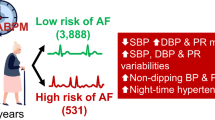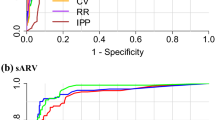Abstract
We evaluated the accuracy of a 24-hr ambulatory blood pressure monitoring (ABPM) device with a new irregular heartbeat (IHB) algorithm for detecting atrial fibrillation (AF) during each BP measurement. Ninety patients with a history of elevated BP and some type of arrhythmia (mean age 63.2 ± 10.3 years; 94% with hypertension; 81% with previously diagnosed AF) simultaneously underwent evaluation by 24-hr ABPM with the IHB algorithm and 24-hr Holter electrocardiography (ECG). Among the 3,347 valid readings, 843 readings were considered to indicate an IHB. Among these IHB readings, 195 readings were found to have an AF rhythm by 24-hr Holter ECG. The IHB algorithm showed 100% sensitivity and 79.4% specificity for accurately detecting AF rhythm. An IHB was detected in 12.1% of the measurements during normal rhythm, 48.8% of those during atrial premature complex, and 54.4% of those during ventricular premature complex. The percentage of IHBs detected during normal rhythm was higher in the daytime than at nighttime (16.3% vs. 4.5%, respectively), suggesting that daytime physical activity sometimes induces a false detection of IHBs. The optimal IHB parameters for suggesting potential AF were (1) an IHB burden defined as a percentage of IHB-positive readings in total valid BP measurements >22.5% (84.6% sensitivity, 85.1% specificity; AUC 0.906, p < 0.0001) and (2) 2.5 or more consecutive IHBs during 24-hr ABPM (84.6% sensitivity, 83.0% specificity; AUC 0.881, p < 0.0001). The novel 24-hr ABPM device with the IHB algorithm assessed herein could contribute to the future comprehensive management of hypertensive patients, with the main goal of preventing cerebrovascular events.
This is a preview of subscription content, access via your institution
Access options
Subscribe to this journal
Receive 12 print issues and online access
$259.00 per year
only $21.58 per issue
Buy this article
- Purchase on Springer Link
- Instant access to full article PDF
Prices may be subject to local taxes which are calculated during checkout

Similar content being viewed by others
References
Benjamin EJ, Wolf PA, D’Agostino RB, Silbershatz H, Kannel WB, Levy D. Impact of atrial fibrillation on the risk of death: the Framingham Heart Study. Circulation 1998;98:946–52.
Kario K, Abe T, Kanegae H. Impact of pre-existing hypertension and control status before atrial fibrillation onset on cardiovascular prognosis in patients with non-valvular atrial fibrillation: a real-world database analysis in Japan. J Clin Hypertens. 2020;22:431–7.
Gage BF, Waterman AD, Shannon W, Boechler M, Rich MW, Radford MJ. Validation of clinical classification schemes for predicting stroke: results from the National Registry of Atrial Fibrillation. JAMA 2001;285:2864–70.
Bassand JP, Accetta G, Camm AJ, Cools F, Fitzmaurice DA, Fox KA, et al. Two-year outcomes of patients with newly diagnosed atrial fibrillation: results from GARFIELD-AF. Eur Heart J. 2016;37:2882–9.
Senoo K, Suzuki S, Sagara K, Otsuka T, Matsuno S, Funada R, et al. Distribution of first-detected atrial fibrillation patients without structural heart diseases in symptom classifications. Circ J. 2012;76:1020–3.
Steinberg JS, Varma N, Cygankiewicz I, Aziz P, Balsam P, Baranchuk A, et al. 2017 ISHNE-HRS expert consensus statement on ambulatory ECG and external cardiac monitoring/telemetry. Heart Rhythm. 2017;14:e55–e96.
Kabutoya T, Takahashi S, Watanabe T, Imai Y, Uemoto K, Yasui N, et al. Diagnostic accuracy of an algorithm for detecting atrial fibrillation in a wrist‐type pulse‐wave monitor. J Clin Hypertens. 2019;21:1393–8.
Kyriakoulis KG, Kollias A, Anagnostopoulos I, Gravvani A, Kalogeropoulos P, Destounis A, et al. Diagnostic accuracy of a novel cuffless self-blood pressure monitor for atrial fibrillation screening in the elderly. J Clin Hypertens. 2019;21:1797–802.
Watanabe T, Tomitani N, Yasui N, Kabutoya T, Hoshide S, Kario K. Assessment of a new algorithm to detect atrial fibrillation in home blood pressure monitoring device among healthy adults and patients with atrial fibrillation. 1. J Clin Hypertens. 2021;23:1085–8.
Kabutoya T, Imai Y, Hoshide S, Kario K. Diagnostic accuracy of a new algorithm to detect atrial fibrillation in a home blood pressure monitor. 1. J Clin Hypertens. 2017;19:1143–7.
Kario K, Shin J, Chen CH, Buranakitjaroen P, Chia YC, Divinagracia R, et al. Expert panel consensus recommendations for ambulatory blood pressure monitoring in Asia: The HOPE Asia Network. J Clinc Hypertens. 2019;21:1250–83.
Kario K, Hoshide S, Saito K, Sato K, Hamasaki H, Suwa H, et al. Validation of the TM-2441 ambulatory blood pressure measurement device according to the ISO 81060-2: 2013 standard. Blood Press Monit. 2019;24:38–41.
Chong BH, Pong V, Lam KF, Liu S, Zuo ML, Lau YF, et al. Frequent premature atrial complexes predict new occurrence of atrial fibrillation and adverse cardiovascular events. Europace 2012;14:942–7.
Binici Z, Intzilakis T, Nielsen OW, Køber L, Sajadieh A. Excessive supraventricular ectopic activity and increased risk of atrial fibrillation and stroke. Circulation 2010;121:1904–11.
Watanabe T, Tomitani N, Kario K. Perspectives on an ambulatory blood pressure monitoring device with novel technology for pulse waveform analysis to detect arrhythmias. J Clin Hypertens. 2020;22:1525–9.
Kollias A, Destounis A, Kalogeropoulos P, Kyriakoulis KG, Ntineri A, Stergiou GS. Atrial fibrillation detection during 24-hour ambulatory blood pressure monitoring: comparison with 24-hour electrocardiography. Hypertension 2018;72:110–5.
Haïssaguerre M, Jaïs P, Shah DC, Takahashi A, Hocini M, Quiniou G, et al. Spontaneous initiation of atrial fibrillation by ectopic beats originating in the pulmonary veins. N. Engl J Med. 1998;339:659–66.
Larsen BS, Kumarathurai P, Falkenberg J, Nielsen OW, Sajadieh A. Excessive atrial ectopy and short atrial runs increase the risk of stroke beyond incident atrial fibrillation. J Am Coll Cardiol. 2015;66:232–41.
Xie F, Xu J, Xia LL, Luo X, Jiang Z, Wu Y, et al. The impact of atrial fibrillation on accuracy of oscillometric blood pressure measurement: effect of ventricular rate. Hypertens Res. 2020;43:518–24.
Norioka N, Iwata S, Ito A, Tamura S, Kawai Y, Nonin S, et al. Greater nighttime blood pressure variability is associated with left atrial enlargement in atrial fibrillation patients with preserved ejection fraction. Hypertens Res. 2018;41:614–21.
Miao F, Zhou B, Liu Z, Wen B, Li Y, Tang M. Using noninvasive adjusted pulse transit time for tracking beat-to-beat systolic blood pressure during ventricular arrhythmias. Hypertens Res. 2022;45:424–35.
Watanabe T, Hoshide S, Kario K. Non-invasive method to validate the variability of blood pressure during arrhythmias. Hypertens Res. 2022;45:530–2.
Cai P, Zhong W, Wang Y, Wang X. Effects of white-coat, masked and sustained hypertension on coronary artery stenosis and cardiac arrhythmia. Hypertens Res. 2020;43:121–31.
Okumura T, Kimura Y, Murohara T. Heart rate control using beta-blockers for heart failure with atrial fibrillation: more than enough is too much. Hypertens Res. 2019;42:1826–7.
Hudoyo AW, Fukuda H, Imazu M, Shindo K, Fu H, Iwata Y, et al. Heart rate determines the beneficial effects of beta-blockers on cardiovascular outcomes in patients with heart failure and atrial fibrillation. Hypertens Res. 2019;42:1716–25.
Kario K. Hemodynamic biomarker-initiated anticipation medicine in the future management of hypertension. Am J Hypertens. 2017;30:226–8.
Kario K, Tomitani N, Kanegae H, Yasui N, Nishizawa M, Fujiwara T, et al. Development of a new ICT-based multisensor blood pressure monitoring system for use in hemodynamic biomarker-initiated anticipation medicine for cardiovascular disease: The National IMPACT Program Project. Prog Cardiovasc Dis. 2017;60:435–49.
Kario K, Tomitani N, Kanegae H, Yasui N, Nagai R, Harada H. The further development of out-of-office BP monitoring: Japan’s ImPACT Program Project’s achievements, impact, and direction. J Clin Hypertens. 2019;21:344–9.
Acknowledgements
We thank A&D Co. for the valuable advice about the ABPM device. A&D had no role in any of the study’s statistical analyses. NY is an employee of A&D Co.
Funding
This study was financially supported in part by a grant from the Japan Society for the Promotion of Science (JSPS) (KAKENHI, no. 20K08456) to T. Watanabe. The study was also funded in part by A&D Co. KK has received research funding from A&D Co.
Author information
Authors and Affiliations
Corresponding author
Ethics declarations
Conflict of interest
The authors declare no competing interests.
Additional information
Publisher’s note Springer Nature remains neutral with regard to jurisdictional claims in published maps and institutional affiliations.
Supplementary information
Rights and permissions
About this article
Cite this article
Watanabe, T., Tomitani, N., Yasui, N. et al. Validation of an ambulatory blood pressure monitoring device employing a novel method to detect atrial fibrillation. Hypertens Res 45, 1345–1352 (2022). https://doi.org/10.1038/s41440-022-00925-0
Received:
Revised:
Accepted:
Published:
Issue Date:
DOI: https://doi.org/10.1038/s41440-022-00925-0
Keywords
This article is cited by
-
Digital hypertension towards to the anticipation medicine
Hypertension Research (2023)
-
Concept, study design, and baseline blood pressure control status of the nationwide prospective HI–JAMP study using multisensor ABPM
Hypertension Research (2023)
-
Quality is not an act, it is a habit—Aristotle
Hypertension Research (2023)
-
Ambulatory blood pressure monitoring with atrial fibrillation detection algorithm: two birds with one stone
Hypertension Research (2023)
-
Irregular heart rhythm algorithm: a novel strategy to accurately detect atrial fibrillation by ambulatory monitoring of blood pressure
Hypertension Research (2022)



